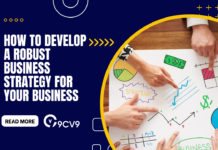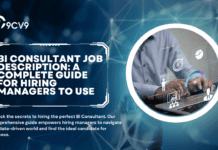Key Takeaways
- Learn how to assess your business needs and align them with the right digital tools and technologies in 2025.
- Discover actionable steps to implement digital transformation strategies that drive growth and efficiency.
- Explore the importance of continuous innovation and change management in sustaining long-term digital success.
In 2025, businesses around the globe are at a critical juncture where digital transformation is no longer optional—it’s essential for survival and growth.
The rapid evolution of technology, coupled with changing consumer expectations and market demands, has forced companies to rethink their operational models, customer engagement strategies, and overall business approach.
Digital transformation, which involves the integration of digital technologies into all areas of business, is not just a trend but a fundamental shift that affects every aspect of a company’s operations.
The need for businesses to embrace digital transformation has never been more urgent.

As organizations strive to remain competitive in an increasingly digital world, adopting advanced technologies like artificial intelligence (AI), machine learning, the Internet of Things (IoT), and cloud computing is no longer a choice but a necessity.
These technologies not only streamline business processes but also unlock new opportunities for innovation, efficiency, and growth.
In 2025, digital transformation is about far more than just upgrading legacy systems.
It’s a complete overhaul of how businesses operate, deliver value to customers, and compete in their respective industries. The integration of cutting-edge technologies allows companies to enhance their agility, improve decision-making through data-driven insights, and foster a culture of continuous innovation.
Digital-first strategies are now the foundation for companies that want to succeed in the fast-paced, ever-changing market environment.
Moreover, the ongoing digitalization of the workforce and the increasing reliance on remote and hybrid working models further emphasize the necessity of digital transformation.
Employees expect seamless collaboration tools, efficient workflows, and systems that enable them to be productive no matter where they are.
Customers, on the other hand, demand personalized experiences, faster services, and more engaging interactions with brands across digital channels. This convergence of demands from both employees and customers is pushing businesses to accelerate their digital journey.
As we step further into 2025, businesses that fail to adapt to the digital landscape risk being left behind. Traditional business models, slow processes, and outdated technologies are no longer viable in a world where real-time responsiveness, automation, and innovation are the cornerstones of success.
Companies must act swiftly to adopt digital solutions that streamline operations, improve customer experiences, and ultimately drive growth.
This step-by-step guide to digital transformation for businesses will explore the key phases of this journey, from assessing your current business environment and setting clear objectives to selecting the right technologies and integrating them into daily operations.
It will also offer insights into the challenges businesses may face during the transformation process and how to navigate them successfully.
Whether you are just beginning to explore digital transformation or looking to optimize your existing initiatives, this guide will provide you with the roadmap to achieve a successful transformation that positions your business for long-term success in the digital age.
In this comprehensive guide, we will delve into actionable strategies and best practices for businesses to not only survive but thrive in a digitally-driven world. By embracing digital transformation, businesses can unlock new levels of efficiency, improve customer engagement, and create a sustainable competitive edge in 2025 and beyond.
Why Digital Transformation is Essential for Businesses in 2025
In 2025, digital transformation is not merely a buzzword; it has become a crucial factor that influences a business’s ability to stay competitive, efficient, and adaptable to change. The rise of digital technologies, along with evolving consumer expectations and market dynamics, means that businesses must fully embrace digitalization to meet the demands of the modern world. Below are key reasons why digital transformation is essential for businesses in 2025:
Enhanced Customer Experience
- Personalized Interactions: Customers expect tailored experiences across all touchpoints. Digital tools like CRM systems, AI-powered chatbots, and data analytics platforms enable businesses to offer highly personalized services, which are vital for building customer loyalty.
- Example: Amazon uses AI to recommend products based on past customer behavior, enhancing the shopping experience and driving sales.
- Real-Time Communication: With the increasing demand for instant responses, businesses must leverage digital channels (e.g., social media, live chat, and automated email systems) to communicate with customers in real time.
- Example: Domino’s Pizza uses a real-time tracking system that allows customers to follow their order from preparation to delivery, improving customer satisfaction.
- Omni-channel Experiences: Customers interact with businesses across various digital platforms—websites, mobile apps, social media, and more. Businesses must offer a seamless experience across these channels to maintain engagement and loyalty.
- Example: Starbucks uses a mobile app that allows customers to order and pay seamlessly across various devices, integrating loyalty programs to enhance the overall experience.
Competitive Advantage
- Staying Ahead of Competitors: In an increasingly digital marketplace, businesses that adopt innovative technologies are better positioned to outpace competitors. Digital transformation empowers companies to innovate faster, adapt to market changes, and deliver cutting-edge products or services.
- Example: Netflix’s investment in AI for content recommendation algorithms helps them maintain their leadership in the streaming industry, outpacing competitors like Hulu and Amazon Prime.
- Agility and Flexibility: Businesses that digitize their processes can respond quickly to changing market conditions, customer needs, and emerging trends. Digital solutions enable faster decision-making, allowing companies to adapt and pivot swiftly.
- Example: Zara uses digital tools to track fashion trends and make quick decisions about inventory management, ensuring they remain competitive in the fast-moving fashion industry.
Operational Efficiency
- Automation of Repetitive Tasks: Digital transformation allows businesses to automate routine processes, reducing manual effort, errors, and operational costs. Automation can streamline everything from customer support to inventory management and payroll.
- Example: Tesla uses automation in its manufacturing processes, significantly reducing production time and costs, enabling them to scale rapidly.
- Improved Collaboration: Cloud-based platforms and digital tools facilitate real-time collaboration among teams, even across different geographies. This boosts productivity, speeds up project timelines, and fosters innovation within organizations.
- Example: Microsoft Teams and Google Workspace have become essential tools for remote teams, enabling seamless communication and collaboration on a global scale.
- Data-Driven Decision Making: The integration of digital technologies enables businesses to collect, analyze, and leverage data in real time. Data-driven insights lead to better decision-making, improved forecasting, and more efficient resource allocation.
- Example: McDonald’s uses data analytics to optimize their supply chain, forecast demand, and ensure that restaurants are adequately stocked with the right ingredients.
Cost Reduction
- Lower Operational Costs: By automating tasks and streamlining business operations, companies can significantly reduce overhead costs associated with manual processes, outdated systems, and inefficiencies.
- Example: General Electric (GE) reduced costs in its supply chain management by integrating IoT technology, allowing the company to monitor equipment health and predict maintenance needs before they result in costly downtime.
- Cloud Computing and Scalability: Cloud services allow businesses to scale their IT infrastructure without the need for large capital expenditures. Companies can pay for resources as they use them, providing flexibility to adjust to demand fluctuations without incurring high costs.
- Example: Dropbox’s cloud storage model enables users to store files without needing expensive physical servers, reducing costs for both the company and its customers.
Employee Empowerment and Satisfaction
- Improved Workflows and Productivity: Digital tools empower employees by providing them with the necessary resources to work more efficiently. Cloud-based software, collaboration platforms, and project management tools help teams stay organized and focused on their core tasks.
- Example: Slack has transformed workplace communication, making it easier for teams to manage projects, share information, and collaborate in real time.
- Remote Work and Flexibility: The rise of remote work in 2025 has made it essential for businesses to adopt digital solutions that support flexible working conditions. Digital transformation facilitates remote work by providing employees with the tools and technologies needed for effective virtual collaboration.
- Example: Zoom has become a cornerstone of remote work, enabling businesses to conduct meetings, webinars, and team collaborations seamlessly.
- Upskilling Employees: Digital transformation allows businesses to invest in employee development through online learning platforms and digital tools that promote continuous learning. This improves employee satisfaction, engagement, and retention.
- Example: AT&T’s investment in upskilling programs, such as its partnership with Udacity to offer employees access to tech courses, is a great example of how companies can empower their workforce through digital initiatives.
Innovation and Long-Term Growth
- Fostering Innovation: The integration of digital technologies encourages businesses to innovate continuously. Companies can use digital tools to test new ideas, quickly prototype products, and launch innovative services that meet market demands.
- Example: Apple’s continuous innovation with its iPhone line—integrating new technologies such as augmented reality (AR) and artificial intelligence—helps the company maintain its position as a market leader.
- New Business Models: Digital transformation opens up opportunities for businesses to explore new business models that were not previously possible. This could include subscription-based services, digital marketplaces, or innovative service delivery methods.
- Example: Spotify disrupted the music industry by offering a subscription-based model for streaming music, which replaced traditional music sales and built a new market segment.
Conclusion
The digital transformation journey is essential for businesses in 2025 to remain competitive, improve operational efficiency, and meet the evolving demands of both customers and employees. From offering personalized experiences and streamlining operations to fostering innovation and reducing costs, embracing digital technologies is a key driver of long-term success. Businesses that do not prioritize digital transformation risk falling behind in an increasingly digital-first world, while those that embrace it can unlock new opportunities for growth, efficiency, and profitability.
Key Drivers of Digital Transformation in 2025
In 2025, digital transformation is being propelled by a dynamic blend of technological advancements, evolving customer expectations, and shifting market forces. These drivers are not isolated; they interact to shape the digital landscape and determine how businesses must respond to maintain competitiveness and relevance. Understanding the key drivers is essential for organizations to formulate effective digital strategies and stay ahead in an increasingly connected world.
Emerging Technologies and Innovation
- Artificial Intelligence (AI) and Machine Learning (ML)
- Enable automation of complex processes and real-time decision-making.
- Help businesses personalize customer interactions and forecast trends with greater accuracy.
- Example: Google’s AI algorithms optimize search results and ad placements, offering highly targeted experiences to users.
- Internet of Things (IoT)
- Expands connectivity between devices, enabling businesses to collect real-time data for operational improvements.
- Drives efficiency in industries like manufacturing, logistics, and healthcare.
- Example: Siemens uses IoT in smart factories to monitor machinery health and optimize production flows.
- Cloud Computing
- Allows organizations to scale infrastructure on demand while minimizing hardware costs.
- Promotes data accessibility, business continuity, and remote collaboration.
- Example: Adobe transitioned its entire product suite to a cloud-based subscription model (Adobe Creative Cloud), improving accessibility and customer engagement.
- 5G and Advanced Connectivity
- Provides faster, more reliable internet speeds that support data-intensive applications and real-time processing.
- Enhances user experience across mobile platforms and remote work environments.
- Example: Verizon’s 5G rollout supports smart cities and enables enterprises to implement real-time IoT solutions.
Changing Customer Expectations
- Demand for Personalization
- Customers expect tailored content, offers, and services based on their preferences and behaviors.
- Drives the need for advanced analytics and customer data platforms.
- Example: Spotify curates personalized playlists using user data and listening history, enhancing engagement and retention.
- Omnichannel Experiences
- Customers expect seamless interactions across web, mobile, social, and in-person touchpoints.
- Encourages businesses to unify customer experiences using integrated platforms.
- Example: Sephora integrates in-store experiences with its mobile app, offering virtual try-ons and personalized recommendations.
- Faster Service and Instant Gratification
- Modern consumers are impatient with delays and expect immediate responses.
- Accelerates the adoption of automation, AI chatbots, and real-time customer support.
- Example: Chatbots like those used by H&M help customers find products, check stock, and resolve issues quickly.
Competitive and Market Pressures
- Industry Disruption by Tech-Enabled Entrants
- Startups and digital-first businesses are reshaping entire industries by leveraging modern technologies.
- Forces traditional businesses to rethink legacy models and embrace innovation.
- Example: Uber disrupted the taxi industry by using a mobile platform to offer seamless ride-hailing services.
- Need for Agility and Innovation
- Companies must innovate rapidly to respond to evolving market demands and economic shifts.
- Encourages agile methodologies and faster go-to-market strategies.
- Example: Tesla’s ability to roll out software updates to its vehicles over-the-air showcases agility in product improvement.
- Globalization and Remote Operations
- As businesses operate globally, they must accommodate diverse markets and workforces.
- Requires robust digital infrastructure to support decentralized operations.
- Example: Amazon operates global e-commerce platforms with localized content and payment options tailored to regional markets.
Workforce Evolution and Talent Expectations
- Rise of Remote and Hybrid Work
- Organizations must support flexible work models with secure digital tools and platforms.
- Promotes the adoption of cloud solutions, project management software, and virtual collaboration tools.
- Example: Atlassian provides digital tools like Jira and Confluence to support remote development and knowledge sharing.
- Digital Skills and Talent Shortages
- The demand for tech-savvy employees continues to rise, creating pressure to upskill existing staff.
- Drives investment in e-learning platforms and digital training programs.
- Example: IBM’s SkillsBuild program offers free digital training to develop workforce capabilities across industries.
- Employee Experience and Engagement
- Organizations must leverage digital solutions to improve internal communication, well-being, and productivity.
- Encourages deployment of employee portals, wellness platforms, and HR automation.
- Example: Salesforce uses its own Employee Experience Cloud to support staff onboarding, engagement, and performance tracking.
Data Explosion and the Need for Intelligent Insights
- Growing Volume of Data
- Businesses generate massive amounts of structured and unstructured data daily.
- Necessitates the use of big data analytics to extract actionable insights.
- Example: Walmart processes over 2.5 petabytes of data every hour to optimize inventory, pricing, and customer engagement.
- Data-Driven Decision Making
- Decision-making increasingly relies on real-time analytics and predictive modeling.
- Promotes transparency, accountability, and strategic foresight.
- Example: Netflix uses viewing data to guide original content creation and predict audience preferences.
- Regulatory Compliance and Data Security
- Data privacy laws like GDPR and CCPA require businesses to protect customer information and ensure transparency.
- Pushes adoption of secure, compliant data management solutions.
- Example: Microsoft Azure provides built-in compliance tools and encryption to help businesses meet regulatory standards.
Sustainability and Corporate Responsibility
- Environmental and Social Governance (ESG)
- Companies are being held accountable for their impact on society and the environment.
- Digital tools help track carbon footprints, manage supply chain transparency, and promote ethical practices.
- Example: Unilever uses digital dashboards to monitor and report on its sustainability KPIs, aligning business with ESG goals.
- Green IT and Energy Efficiency
- Businesses are adopting cloud computing, energy-efficient data centers, and paperless workflows to reduce environmental impact.
- Enhances brand reputation and meets stakeholder expectations.
- Example: Google operates some of the world’s most energy-efficient data centers and is committed to operating on carbon-free energy by 2030.
- Circular Economy and Digital Transparency
- Customers increasingly support brands that promote recycling, reuse, and transparency in production.
- Digital transformation facilitates product tracking and lifecycle management.
- Example: IKEA uses digital product passports to track raw materials and promote sustainability across its value chain.
Conclusion
Digital transformation in 2025 is driven by a convergence of advanced technologies, evolving consumer demands, workforce changes, data proliferation, and sustainability initiatives. These key drivers compel organizations to rethink traditional business models and embrace continuous innovation. By understanding and responding to these forces, businesses can future-proof their operations, enhance customer experiences, and build a resilient, agile, and digitally empowered organization.
Before we venture further into this article, we would like to share who we are and what we do.
About 9cv9
9cv9 is a business tech startup based in Singapore and Asia, with a strong presence all over the world.
With over nine years of startup and business experience, and being highly involved in connecting with thousands of companies and startups, the 9cv9 team has listed some important learning points in this overview of Digital Transformation For Businesses: A Step-by-Step Guide in 2025.
If your company needs recruitment and headhunting services to hire top-quality employees, you can use 9cv9 headhunting and recruitment services to hire top talents and candidates. Find out more here, or send over an email to [email protected].
Or just post 1 free job posting here at 9cv9 Hiring Portal in under 10 minutes.
Digital Transformation For Businesses: A Step-by-Step Guide in 2025
- Assessing Your Business Needs and Goals
- Choosing the Right Digital Tools and Technologies
- Building a Digital Transformation Strategy
- Implementing Change Management Practices
- Integrating Digital Solutions into Business Operations
- Measuring Success and Adjusting Strategies
- Staying Ahead with Continuous Innovation
1. Assessing Your Business Needs and Goals
The first and most critical phase of any successful digital transformation journey in 2025 begins with a comprehensive assessment of your business’s current state, needs, and strategic objectives. Without a deep understanding of what the organization requires and aims to achieve, implementing new digital tools or platforms can result in wasted resources, misaligned strategies, and organizational resistance. This foundational step serves as the blueprint for all subsequent transformation initiatives and must be approached with precision, clarity, and stakeholder input.
Conducting a Holistic Business Evaluation
- Analyze Current Operational Workflows
- Review existing processes across departments to identify inefficiencies or redundancies.
- Determine which functions are manual, outdated, or siloed from other systems.
- Example: A manufacturing firm may discover that its inventory tracking system is manual and prone to human error, leading to supply chain delays.
- Review Technology Infrastructure
- Assess existing digital tools, software, and hardware in use across the organization.
- Identify outdated technologies that may be hindering growth or scalability.
- Example: A retail company using on-premise legacy POS systems might find it difficult to integrate with e-commerce platforms or gather real-time customer data.
- Evaluate Organizational Culture and Digital Readiness
- Gauge employee familiarity with digital tools and openness to change.
- Identify potential resistance points and areas needing training or change management.
- Example: A financial services firm may have experienced teams accustomed to traditional paper-based workflows and reluctant to adopt cloud platforms without proper support.
Identifying Business Pain Points
- Pinpoint Areas with Operational Bottlenecks
- Document tasks or processes that regularly cause delays, errors, or customer dissatisfaction.
- Prioritize pain points based on frequency, impact, and cost implications.
- Example: An HR department struggling with manual payroll systems may face errors and compliance issues, warranting a shift to automated payroll software.
- Understand Customer Experience Challenges
- Collect feedback through surveys, reviews, and support tickets to identify gaps in service delivery.
- Map the customer journey to find friction points in digital touchpoints.
- Example: An e-commerce brand might discover that their mobile app frequently crashes during checkout, resulting in cart abandonment and lost sales.
- Review Financial Performance Metrics
- Evaluate revenue trends, cost structures, and profit margins in relation to operational inefficiencies.
- Determine which underperforming areas could benefit most from digitization.
- Example: A logistics company might see rising fuel and labor costs, prompting interest in route optimization software or autonomous delivery technologies.
Defining Strategic Objectives and Measurable Goals
- Align Digital Goals with Business Vision
- Ensure digital transformation efforts support long-term business direction and mission.
- Define how technology will contribute to growth, innovation, and customer value.
- Example: A healthcare provider aiming to expand telemedicine services should integrate digital transformation efforts around remote care, patient data security, and digital health platforms.
- Set SMART Goals (Specific, Measurable, Achievable, Relevant, Time-bound)
- Define clear outcomes such as improving customer retention by 15% within 12 months using CRM tools.
- Break large goals into smaller milestones to track progress effectively.
- Example: A SaaS startup might aim to reduce customer onboarding time from 10 days to 3 days by implementing automation and in-app guides.
- Determine Key Performance Indicators (KPIs)
- Identify metrics to track transformation success, such as system uptime, customer satisfaction (CSAT), Net Promoter Score (NPS), operational costs, or employee productivity.
- Tailor KPIs to individual departments and transformation goals.
- Example: For marketing teams, KPIs may include digital ad ROI, lead conversion rates, and website traffic growth.
Engaging Stakeholders and Gathering Input
- Involve Key Departments Early
- Collaborate with leaders across sales, marketing, IT, operations, HR, and finance to understand their unique needs.
- Encourage interdepartmental discussions to align goals and avoid digital silos.
- Example: In a retail chain, IT and marketing should work together to ensure CRM integration supports campaign personalization and customer analytics.
- Capture Frontline Employee Feedback
- Seek insights from staff who interact with systems daily, as they often provide practical knowledge about inefficiencies and user experience.
- Include them in decision-making to improve buy-in and relevance of selected digital tools.
- Example: Customer service reps might recommend specific chatbot features based on recurring customer queries they encounter.
- Incorporate Customer Insights
- Understand what your customers expect from digital engagement by analyzing behavior, preferences, and feedback.
- Let customer needs guide product improvements, platform decisions, and service delivery models.
- Example: A travel agency noticing a shift toward self-service bookings may prioritize the development of a mobile app with live availability and booking options.
Performing a Gap Analysis
- Compare Current Capabilities to Desired Outcomes
- Identify the gap between current performance levels and the ideal future state.
- Highlight technology, skills, and process deficiencies that must be addressed.
- Example: A nonprofit wanting to improve donor engagement might realize their current CRM lacks email automation or social media integration.
- Assess Resource Availability
- Determine budget, staffing, and time constraints that will influence implementation scope.
- Evaluate whether the transformation should be phased or require external partners.
- Example: A mid-sized enterprise with limited in-house IT support may need to partner with a managed services provider for implementation.
- Highlight Opportunities for Quick Wins
- Identify low-cost, high-impact initiatives that can demonstrate immediate value.
- These wins build momentum and support for broader transformation.
- Example: Digitizing invoice processing in finance can yield instant efficiency improvements and reduce errors.
Conclusion
Assessing business needs and goals is not just the starting point of digital transformation—it sets the tone for the entire journey. By taking a structured, data-driven approach to understanding operational inefficiencies, aligning with long-term objectives, and engaging stakeholders at every level, businesses can create a strong foundation for meaningful and sustainable digital change. This step ensures that future technology investments are strategically aligned, customer-focused, and built to deliver measurable results.
2. Choosing the Right Digital Tools and Technologies
Once the business’s needs and goals have been clearly assessed, the next step in the digital transformation journey is to identify and adopt the most suitable digital tools and technologies. The right digital solutions are crucial in helping an organization automate processes, enhance customer experience, increase operational efficiency, and stay competitive in a digital-first marketplace. In 2025, with an ever-evolving tech landscape, it’s critical for companies to make informed decisions based on strategic alignment, scalability, integration potential, and ROI.
Understanding Core Technology Categories
- Cloud Computing Solutions
- Essential for enabling scalability, remote access, and cost-effective IT management.
- Offers Infrastructure-as-a-Service (IaaS), Platform-as-a-Service (PaaS), and Software-as-a-Service (SaaS) options.
- Example: A growing startup might adopt AWS or Microsoft Azure to host its applications and scale on-demand without heavy upfront infrastructure costs.
- Customer Relationship Management (CRM) Software
- Centralizes customer data, tracks interactions, and supports personalized marketing and sales strategies.
- Ideal for improving sales conversions, customer engagement, and retention.
- Example: Salesforce or HubSpot can help B2B businesses manage client pipelines and automate lead nurturing workflows.
- Enterprise Resource Planning (ERP) Systems
- Integrates core business functions like finance, inventory, HR, and procurement into a unified platform.
- Reduces redundancy and provides real-time visibility into operations.
- Example: An electronics manufacturer might adopt SAP S/4HANA to streamline inventory control, production planning, and accounting in one system.
- Collaboration and Communication Tools
- Enhances team coordination, especially in hybrid and remote work environments.
- Features like video conferencing, file sharing, and project management are key.
- Example: Tools like Microsoft Teams, Slack, and Asana improve internal communication, task tracking, and document sharing across departments.
- Data Analytics and Business Intelligence (BI) Platforms
- Transforms raw data into actionable insights for decision-making.
- Useful for forecasting, performance tracking, and market analysis.
- Example: A retail chain could use Power BI or Tableau to analyze customer purchasing trends and optimize store layouts accordingly.
- Cybersecurity Tools
- Protects digital assets, data, and infrastructure against increasing cyber threats.
- Includes firewalls, endpoint protection, identity management, and threat detection solutions.
- Example: A healthcare organization may deploy tools like Palo Alto Networks or CrowdStrike to ensure HIPAA compliance and secure patient data.
- AI and Machine Learning Platforms
- Automates tasks, predicts trends, and enables smart decision-making.
- Supports use cases such as fraud detection, recommendation engines, and chatbots.
- Example: An e-commerce site could integrate an AI-powered chatbot like Drift to handle 24/7 customer inquiries and upsell products.
Evaluating Tools Based on Business Objectives
- Fit for Specific Use Cases
- Ensure the tool solves the particular pain point or supports a defined objective.
- Avoid general-purpose tools that do not deliver deep functionality in required areas.
- Example: A logistics company may need a supply chain management tool tailored for fleet tracking, not just general ERP capabilities.
- Integration with Existing Systems
- Choose tools that can seamlessly integrate with current platforms, avoiding silos.
- Prioritize APIs, plug-ins, and compatibility with legacy systems.
- Example: An organization already using QuickBooks for accounting should ensure the chosen CRM or ERP system can sync financial data in real time.
- Scalability and Future Growth Support
- Opt for platforms that can grow with the company’s size, user base, and feature requirements.
- Cloud-based and modular systems are typically more flexible for future scaling.
- Example: A mid-size company planning international expansion may choose a multi-currency, multi-language ERP system like Oracle NetSuite.
- User Experience and Accessibility
- Evaluate the interface design, ease of use, mobile compatibility, and onboarding process.
- Tools with intuitive UI help drive adoption and reduce training costs.
- Example: A field service company might prefer a mobile-first scheduling app like ServiceTitan that allows technicians to manage jobs from smartphones.
- Vendor Reliability and Support
- Assess vendor reputation, industry track record, and customer service responsiveness.
- Consider SLA agreements, technical documentation, and community forums.
- Example: A fintech startup might favor a cybersecurity vendor with proven uptime guarantees and dedicated support for regulated industries.
Considering Cost and Return on Investment (ROI)
- Upfront and Ongoing Costs
- Factor in licensing fees, customization expenses, maintenance costs, and training resources.
- Calculate Total Cost of Ownership (TCO) over the tool’s expected lifecycle.
- Example: Subscription-based SaaS platforms like Monday.com may seem affordable upfront but can accumulate costs as team size grows.
- ROI Metrics and Timeframes
- Estimate the potential gains in efficiency, revenue, or customer satisfaction.
- Establish KPIs to measure ROI such as time saved, reduction in errors, or increase in customer lifetime value.
- Example: Implementing automated invoice processing can reduce labor hours by 70% and pay for itself within six months.
- Free Trials and Pilot Programs
- Test tools in controlled environments to evaluate performance and fit.
- Involve end-users in pilot evaluations to gather feedback.
- Example: A law firm might test document automation software like DocuSign CLM for 30 days before company-wide deployment.
Staying Current with Emerging Technologies
- Adopting Edge Technologies Strategically
- Keep an eye on innovation areas like blockchain, edge computing, and quantum AI.
- Adopt these technologies only when they align with industry needs and business strategies.
- Example: A supply chain business might use blockchain to increase transparency and traceability of goods.
- Industry-Specific Digital Tools
- Leverage platforms built for specific verticals such as hospitality, healthcare, or manufacturing.
- These often include compliance features and industry-standard integrations.
- Example: A hotel may benefit from hospitality-focused PMS (Property Management Systems) like Cloudbeds, which include booking, CRM, and billing modules.
- Monitoring Competitor and Market Trends
- Observe which tools peers and industry leaders are adopting.
- Benchmark performance improvements and innovation success stories.
- Example: If competitors in the automotive sector adopt predictive maintenance platforms, it might be time to consider IoT-driven diagnostics.
Involving Stakeholders in Technology Decisions
- Cross-Departmental Input for Tool Selection
- Form a digital transformation committee with representation from IT, operations, finance, HR, and customer service.
- Promote transparency and shared ownership of technology decisions.
- Example: In selecting a new CRM, input from both sales and marketing is essential to ensure it aligns with customer engagement goals.
- Engaging End Users in Usability Testing
- Involve actual users in testing demo versions of the tools.
- Use their feedback to identify training needs and functionality gaps.
- Example: A hospital choosing an EHR (Electronic Health Records) system should involve both doctors and administrative staff in the evaluation phase.
- Ensuring Executive Buy-In
- Gain leadership support by demonstrating the strategic and financial benefits of proposed technologies.
- Present use cases and ROI projections to justify investment.
- Example: A CEO may be more convinced of the need for AI-powered analytics after seeing how it led to 30% revenue growth in a competitor’s case study.
Conclusion
Selecting the right digital tools and technologies is a pivotal step in the digital transformation process. It requires a careful balance between functionality, integration, cost, and long-term scalability. By aligning technology choices with business objectives and involving relevant stakeholders in the selection process, organizations can ensure successful adoption and maximize the benefits of their digital investments. In 2025’s fast-paced digital environment, strategic tech adoption is no longer optional—it’s essential for survival and sustained growth.
3. Building a Digital Transformation Strategy
After evaluating business goals and selecting appropriate digital tools, the next critical phase is to build a comprehensive digital transformation strategy. This strategy acts as a roadmap, aligning technology initiatives with business objectives, employee capabilities, and customer expectations. A well-structured plan ensures a seamless, phased rollout of transformation efforts while minimizing risks, managing change, and measuring outcomes effectively.
Defining Clear Strategic Objectives
- Align Digital Goals with Business Vision
- Ensure that digital transformation efforts are in harmony with long-term organizational objectives.
- Example: A retail company aiming for omnichannel growth should prioritize e-commerce integration, digital inventory management, and customer data unification.
- Set Measurable and Time-Bound KPIs
- Define quantifiable metrics such as customer acquisition cost, time-to-market, process automation rate, or digital sales percentage.
- Example: A manufacturing firm might aim to reduce manual production errors by 50% within 12 months through IoT integration and automation.
- Identify Short-Term Wins and Long-Term Goals
- Balance immediate improvements (e.g., adopting project management software) with larger, ongoing transformation (e.g., full ERP implementation).
- Example: A service-based company could first digitize appointment booking before deploying a complete CRM platform.
Segmenting Transformation into Phases
- Phase 1: Digitization of Core Processes
- Begin by digitizing paper-based or manual workflows.
- Example: A law firm might start with document automation and cloud storage for legal contracts.
- Phase 2: Automation and Data Integration
- Implement process automation tools and link systems to eliminate data silos.
- Example: An HR department could integrate recruitment software with payroll and onboarding platforms.
- Phase 3: Advanced Analytics and Customer Insights
- Use AI and BI tools to derive data-driven insights for strategic decision-making.
- Example: A telecom provider might use predictive analytics to forecast customer churn and personalize retention campaigns.
- Phase 4: Culture and Innovation Enablement
- Foster a digital mindset across teams and encourage innovation through continuous learning.
- Example: A bank may run internal innovation labs to explore blockchain use cases and prototype new customer services.
Stakeholder Engagement and Change Management
- Involve All Departments from the Start
- Include cross-functional teams to avoid isolated decision-making and ensure enterprise-wide alignment.
- Example: During a CRM rollout, involve both sales and customer service to tailor workflows for real use cases.
- Develop a Clear Change Management Plan
- Prepare the organization for change by communicating goals, addressing resistance, and offering support.
- Example: A healthcare organization implementing a new EHR system should provide structured training and change champions in each department.
- Secure Executive Sponsorship
- Ensure leadership is committed and vocal about the transformation strategy.
- Example: A CEO might lead quarterly town halls to share updates and reinforce the strategic vision behind digital changes.
Mapping Out Resource Allocation
- Budgeting for Transformation Projects
- Allocate funding for technology acquisition, system upgrades, training, and ongoing maintenance.
- Example: An SMB might dedicate 20% of its IT budget to implement a cloud-based ERP with phased deployment.
- Human Capital and Talent Management
- Assess skill gaps and plan for upskilling or hiring tech-savvy professionals.
- Example: A logistics firm may need to recruit data analysts to interpret fleet data for predictive maintenance.
- Time and Milestone Planning
- Set realistic timelines and checkpoints for each phase of the transformation.
- Example: A digital banking rollout might follow a 6-month timeline with milestones for mobile app beta testing, backend API integration, and final launch.
Ensuring Scalability and Flexibility
- Plan for Future Technology Expansion
- Design systems that can integrate emerging technologies and handle increased data volumes or users.
- Example: A media company investing in a content management platform should choose one that supports video streaming and AI tagging as future capabilities.
- Create a Modular Strategy
- Use a modular approach that allows independent upgrades or changes without disrupting the entire ecosystem.
- Example: A fashion retailer might upgrade its e-commerce recommendation engine without needing to rebuild the entire website.
- Incorporate Customer Feedback Loops
- Use customer data and feedback to inform ongoing improvements.
- Example: A SaaS business might integrate Net Promoter Score (NPS) surveys into its app to refine the user interface and new features.
Risk Management and Compliance Planning
- Conduct Digital Risk Assessments
- Identify potential vulnerabilities in systems, workflows, or data governance.
- Example: A fintech startup must evaluate risks around customer data storage, access control, and financial fraud.
- Ensure Regulatory Compliance
- Align transformation efforts with industry-specific standards (e.g., GDPR, HIPAA, ISO).
- Example: An insurance firm must incorporate digital signature solutions that comply with local e-signature regulations.
- Develop Contingency and Backup Plans
- Create fail-safes and recovery protocols in case of technology failure or security breaches.
- Example: A data center should have a disaster recovery plan involving real-time data backups and geographically distributed servers.
Communicating the Strategy Internally
- Build a Clear Communication Framework
- Use regular meetings, updates, and digital platforms to share strategy progress.
- Example: An enterprise can create a dedicated transformation portal where employees track initiatives, updates, and success metrics.
- Celebrate Milestones and Wins
- Recognize achievements during each stage to build momentum and morale.
- Example: When a retail chain successfully launches its mobile loyalty app, leadership can spotlight the team behind the rollout.
- Encourage Feedback and Participation
- Create channels for employees to share experiences, challenges, and ideas during implementation.
- Example: A tech company might launch an internal Slack channel specifically for transformation suggestions and collaboration.
Monitoring, Measuring, and Refining the Strategy
- Establish a Performance Monitoring System
- Use dashboards and analytics tools to track progress toward digital KPIs.
- Example: A logistics company may monitor real-time delivery tracking rates, route optimization efficiency, and customer feedback ratings.
- Conduct Regular Strategy Reviews
- Assess what’s working and where adjustments are needed.
- Example: If a marketing automation tool fails to increase conversion rates, the team may reassess campaign design or switch vendors.
- Iterate and Scale Based on Insights
- Treat the strategy as a living document that evolves with business conditions and market demands.
- Example: A restaurant chain that first digitizes ordering and later adds AI-powered menu personalization based on customer behavior trends.
Conclusion
Building a successful digital transformation strategy in 2025 requires a well-orchestrated, cross-functional effort grounded in clear goals, phased execution, stakeholder engagement, and continuous improvement. By constructing a scalable and data-driven roadmap, businesses not only enhance their operational capabilities but also future-proof their organization against evolving market dynamics. A strong strategy transforms digital ambitions into actionable realities, ensuring lasting competitive advantage.
4. Implementing Change Management Practices
Effective change management is a critical success factor in any digital transformation initiative. Without a structured approach to managing change, even the most innovative technologies and strategies can fail to gain traction. In 2025, organizations must not only adopt new technologies but also drive mindset and cultural shifts to ensure long-term success. Implementing robust change management practices ensures employees embrace the transformation, reduces resistance, and promotes organizational resilience in an evolving digital landscape.
Understanding the Importance of Change Management
- Ensures alignment between people, processes, and technology during digital transformation.
- Reduces resistance to change and increases user adoption of new tools and systems.
- Helps maintain productivity and morale during periods of transition.
- Builds a culture of agility, innovation, and continuous improvement.
- Example: A hospital implementing a new Electronic Health Record (EHR) system uses structured change management to train staff, ensure compliance, and reduce operational disruptions.
Building a Dedicated Change Management Team
- Appoint Change Leaders or Champions
- Identify influential individuals within departments who can advocate for the change.
- Empower them to guide peers, address concerns, and support the implementation process.
- Example: A bank rolling out a new digital customer service platform designates senior customer service reps as change champions.
- Create a Cross-Functional Change Management Team
- Include members from HR, IT, operations, and communications to provide diverse perspectives.
- Ensure collaboration across departments for coordinated change initiatives.
- Example: A manufacturing firm forms a digital transformation task force involving plant managers, IT specialists, and HR leads.
Developing a Change Management Strategy
- Define the Vision and Objectives for Change
- Communicate why the change is necessary, what it aims to achieve, and how it aligns with company goals.
- Keep messaging consistent across all departments.
- Example: A logistics company explains that its shift to AI-powered route optimization is aimed at reducing delivery times and fuel consumption.
- Assess Change Readiness Across the Organization
- Conduct surveys or interviews to evaluate employees’ openness to change.
- Identify departments or individuals that may require additional support.
- Example: An insurance provider launching a digital claims platform assesses digital literacy levels before implementation.
- Create a Communication Plan
- Share updates regularly via email, intranet, meetings, and internal webinars.
- Address the “what’s in it for me” (WIIFM) for employees to increase engagement.
- Example: A retail chain launching a digital inventory management system shares video walkthroughs and FAQ documents in weekly newsletters.
Engaging Employees in the Change Process
- Promote Active Involvement
- Involve staff in pilot programs, tool testing, and feedback collection.
- Foster a sense of ownership and inclusivity.
- Example: A tech company involves developers and designers in co-creating a new agile workflow system.
- Provide Transparent Feedback Channels
- Allow employees to voice concerns, share insights, and suggest improvements.
- Example: A consulting firm creates a dedicated Slack channel for transformation-related feedback and ideas.
- Celebrate Quick Wins
- Recognize early adopters and teams that successfully embrace changes.
- Share success stories across the organization.
- Example: After migrating to a new CRM, a sales team that exceeds performance targets is highlighted in an internal newsletter.
Conducting Training and Upskilling Programs
- Deliver Role-Based Training Programs
- Tailor learning content based on job functions and software usage needs.
- Example: A healthcare provider offers separate training for nurses, admin staff, and doctors on a newly implemented patient management system.
- Use a Variety of Learning Methods
- Combine instructor-led sessions, on-demand video tutorials, live demos, and interactive e-learning platforms.
- Example: A legal firm uses microlearning videos to train staff on using cloud-based document collaboration tools.
- Track Training Effectiveness
- Measure engagement, completion rates, and post-training performance metrics.
- Provide follow-up sessions or refresher courses if needed.
- Example: A construction company uses quizzes and on-the-job assessments to ensure workers are proficient in using digital site management software.
Managing Resistance to Change
- Identify Sources of Resistance Early
- Monitor feedback, participation levels, and communication engagement.
- Recognize common fears such as job loss, lack of skills, or loss of control.
- Example: In an HR software rollout, HR staff express concern about automation; leadership reassures them by demonstrating enhanced roles.
- Apply Targeted Interventions
- Provide one-on-one support, mentorship, or counseling for resistant individuals.
- Address misconceptions and reinforce the benefits of change.
- Example: A university’s IT department hosts town hall Q&A sessions to address faculty concerns over switching to a new learning management system.
- Use Positive Reinforcement
- Offer incentives, public recognition, or career development opportunities tied to change adoption.
- Example: Employees who successfully adopt a new cybersecurity protocol receive digital badges and recognition during monthly meetings.
Measuring and Sustaining Change
- Monitor Post-Implementation Adoption Rates
- Use analytics dashboards to assess system usage and workflow efficiency.
- Identify areas of non-compliance or poor adoption.
- Example: An e-commerce platform tracks the usage of its automated inventory system across warehouses to ensure full implementation.
- Conduct Pulse Surveys and Feedback Reviews
- Periodically gather employee insights to gauge ongoing satisfaction and issues.
- Use feedback to make iterative improvements.
- Example: A telecom provider gathers post-implementation feedback on its customer service chatbot and rolls out updates based on user suggestions.
- Institutionalize New Behaviors
- Embed new processes into daily operations, performance metrics, and company culture.
- Example: A digital marketing firm incorporates the use of real-time analytics dashboards into weekly team review meetings.
- Maintain Momentum with Continuous Improvement
- Encourage teams to explore new innovations and build upon existing changes.
- Create a culture of experimentation and agility.
- Example: After successfully implementing remote collaboration tools, a design agency experiments with virtual whiteboard solutions to enhance brainstorming sessions.
Ensuring Leadership Involvement
- Demonstrate Executive Support
- Leaders should model the change they want to see.
- Participate actively in communication campaigns, training, and milestone celebrations.
- Example: The CIO of a fintech firm hosts monthly strategy updates to keep staff engaged with ongoing digital changes.
- Empower Managers to Support Teams
- Train mid-level managers to reinforce change messaging and provide local support.
- Example: Department heads receive training on coaching techniques to help their teams transition to new systems confidently.
- Align Leadership KPIs with Transformation Goals
- Make change-related performance indicators part of leadership evaluation.
- Example: A logistics firm links operational managers’ bonuses to successful tech adoption rates and process improvements.
Conclusion
Implementing change management practices is essential to ensure that digital transformation initiatives in 2025 are not only adopted but also sustained over the long term. By preparing employees, addressing resistance, and building a culture that embraces innovation and continuous learning, businesses can navigate the complexities of transformation more smoothly. Successful change management bridges the gap between strategy and execution, enabling organizations to maximize the value of their digital investments.
5. Integrating Digital Solutions into Business Operations
Integrating digital solutions into business operations is a pivotal phase of digital transformation. It is not enough to simply acquire new technologies; businesses must embed these solutions seamlessly into their daily workflows to realize their full potential. Effective integration ensures operational efficiency, enhances customer experiences, boosts data-driven decision-making, and drives innovation. In 2025, successful integration strategies are characterized by a holistic approach that bridges technology, processes, and people.
Evaluating Operational Workflows
- Map Current Business Processes
- Document all existing workflows, from supply chain management to customer service, to understand how work currently gets done.
- Identify bottlenecks, inefficiencies, and redundant steps that digital solutions could address.
- Example: A logistics company maps its manual inventory tracking system and finds delays caused by paper-based processes.
- Analyze Technology Touchpoints
- Review all points where technology intersects with business processes.
- Highlight gaps where outdated systems hinder operational efficiency.
- Example: A retailer discovers that its outdated POS system does not integrate with its e-commerce platform, leading to inventory inaccuracies.
- Prioritize Areas for Digital Integration
- Focus on areas with the highest potential ROI and operational impact.
- Example: A healthcare provider prioritizes integrating telehealth platforms to enhance patient access and reduce wait times.
Selecting Integration Approaches
- Choose Between Full System Replacement and Incremental Integration
- Full replacement involves deploying a new, unified system across operations.
- Incremental integration involves adding digital tools to existing systems without complete overhaul.
- Example: A manufacturing firm replaces its legacy ERP with a cloud-based solution, while an accounting firm adds AI-based expense tracking tools to its existing software.
- Consider API-Based Integration
- Use Application Programming Interfaces (APIs) to connect disparate systems and enable seamless data flow.
- Example: A marketing agency integrates its CRM, email marketing platform, and social media tools using APIs for better campaign tracking.
- Implement Modular Solutions
- Deploy digital solutions that can be easily expanded or customized over time.
- Example: An e-commerce company adopts a modular website platform that allows easy addition of AI-based personalization features later.
Aligning Technology with Business Objectives
- Ensure Solution Compatibility with Business Goals
- Match each digital solution to specific business objectives, such as enhancing customer service, improving supply chain efficiency, or increasing data visibility.
- Example: A hotel chain integrates a cloud-based booking system to streamline reservation management and improve guest experience.
- Incorporate Scalability and Flexibility
- Choose digital solutions that can scale with business growth and adapt to evolving needs.
- Example: A startup implements a scalable cloud storage solution that grows with its expanding data needs.
- Build a Future-Proof Infrastructure
- Select technologies designed to integrate with emerging technologies like AI, blockchain, and IoT.
- Example: A logistics company invests in IoT-ready fleet management systems to prepare for autonomous delivery capabilities.
Streamlining Data Integration
- Establish Centralized Data Repositories
- Create a single source of truth by consolidating data from multiple systems into unified databases or data lakes.
- Example: A pharmaceutical company integrates research, production, and sales data into a centralized analytics platform.
- Standardize Data Formats and Structures
- Ensure consistent data entry protocols and formats to prevent errors and enhance interoperability.
- Example: A financial services firm standardizes client information formats across CRM, accounting, and compliance platforms.
- Implement Data Governance Policies
- Define clear guidelines for data security, access rights, and compliance to protect sensitive information.
- Example: A healthcare organization implements strict HIPAA-compliant data governance protocols across its digital health records system.
Training Employees on Integrated Systems
- Conduct Comprehensive Training Sessions
- Offer role-specific training that covers new system functionalities, best practices, and troubleshooting.
- Example: After integrating a new project management tool, a construction company provides separate training tracks for project managers, site supervisors, and contractors.
- Offer Continuous Learning Opportunities
- Provide access to ongoing workshops, webinars, and online learning modules to reinforce skills and adapt to system updates.
- Example: A marketing firm provides quarterly webinars on advanced CRM features to keep staff proficient.
- Encourage Peer-to-Peer Learning
- Set up mentorship or buddy systems where experienced users support their colleagues.
- Example: A software company encourages experienced developers to mentor junior staff on using the newly integrated DevOps platform.
Monitoring and Optimizing Integrated Operations
- Establish Key Performance Indicators (KPIs)
- Define metrics to measure the success of integration efforts, such as process completion times, error rates, and customer satisfaction scores.
- Example: A retail company tracks the average checkout time before and after integrating a mobile POS system.
- Conduct Regular System Audits
- Schedule periodic reviews of integrated systems to ensure they operate as intended and to identify potential improvements.
- Example: A logistics firm audits its automated warehouse management system quarterly to assess efficiency and accuracy.
- Solicit Ongoing Feedback from Users
- Encourage employees to share their experiences and suggest enhancements to the integrated systems.
- Example: An insurance company uses anonymous surveys to gather employee feedback on the usability of its newly integrated claims processing platform.
- Optimize Through Iterative Improvements
- Continuously refine workflows and system configurations based on performance data and user feedback.
- Example: A SaaS provider adjusts its customer support workflows after integrating AI chatbots based on real-time analytics of user interactions.
Ensuring Business Continuity During Integration
- Develop Risk Management Plans
- Identify potential integration risks and create mitigation strategies, such as backup systems and phased rollouts.
- Example: A financial services provider creates contingency plans before integrating a new mobile banking platform.
- Implement Pilot Programs and Phased Rollouts
- Test digital solutions in controlled environments or small business units before full-scale deployment.
- Example: A healthcare provider pilots a new telemedicine app with one department before expanding it hospital-wide.
- Maintain Open Communication Channels
- Keep all stakeholders informed about integration timelines, expected impacts, and progress updates.
- Example: A real estate firm issues weekly updates during the integration of a new property management system to keep agents and staff aligned.
Conclusion
Successfully integrating digital solutions into business operations is a vital step in ensuring that digital transformation initiatives deliver tangible benefits. In 2025, businesses must approach integration strategically by aligning technology with business goals, streamlining data, empowering employees, monitoring performance, and ensuring operational continuity. When digital solutions are fully embedded into core processes, organizations can achieve heightened efficiency, innovation, and competitive advantage in an increasingly digital-first world.
6. Measuring Success and Adjusting Strategies
Measuring the success of digital transformation initiatives and making strategic adjustments is crucial for ensuring long-term growth and sustainability. In 2025, organizations must implement robust evaluation frameworks to track progress, identify gaps, and adapt to dynamic business environments. Accurate measurement not only highlights achievements but also uncovers areas for continuous improvement, allowing businesses to remain agile and competitive.
Defining Key Performance Indicators (KPIs)
- Align KPIs with Business Objectives
- Establish KPIs that directly correlate with the overarching goals of the digital transformation journey, such as customer satisfaction, operational efficiency, and revenue growth.
- Example: A retail company uses customer retention rates and average order value as KPIs for its e-commerce transformation.
- Select Both Leading and Lagging Indicators
- Leading indicators predict future success (e.g., website engagement rates), while lagging indicators reflect past performance (e.g., quarterly sales growth).
- Example: A SaaS provider monitors free trial signups (leading) and subscription renewals (lagging) to evaluate its new CRM integration.
- Customize KPIs Across Departments
- Different departments should have tailored KPIs based on their roles in the transformation strategy.
- Example: The IT department tracks system uptime, while the marketing team measures digital campaign ROI.
Implementing Effective Measurement Tools
- Use Real-Time Analytics Platforms
- Deploy analytics tools that provide real-time insights into business performance and customer behavior.
- Example: An online retailer uses Google Analytics and Shopify dashboards to monitor conversion rates daily.
- Integrate Business Intelligence (BI) Systems
- Centralize data from multiple sources to provide comprehensive, actionable insights through BI dashboards.
- Example: A healthcare network integrates patient records, billing, and feedback surveys into a unified BI platform for analysis.
- Employ Customer Feedback Tools
- Implement surveys, NPS (Net Promoter Score) tools, and online review monitoring to gauge customer sentiment.
- Example: A financial services firm uses post-service surveys to measure client satisfaction after adopting a new mobile banking app.
Analyzing Performance Data
- Conduct Regular Performance Reviews
- Schedule monthly or quarterly reviews to assess the effectiveness of digital transformation initiatives.
- Example: A logistics company reviews warehouse automation KPIs quarterly to evaluate efficiency improvements.
- Identify Trends and Patterns
- Analyze data over time to uncover trends, such as increasing online engagement or declining support requests.
- Example: A telecom company notices a 20% reduction in customer service calls after implementing an AI chatbot.
- Compare Against Benchmarks and Industry Standards
- Evaluate performance relative to industry averages or historical company data to understand competitiveness.
- Example: A cybersecurity firm benchmarks its threat detection times against industry leaders to gauge its technological advancements.
Adjusting Strategies Based on Insights
- Revise Digital Transformation Roadmaps
- Update project plans, timelines, and resource allocations based on performance insights and emerging opportunities.
- Example: A manufacturing firm reallocates budget from underperforming IoT initiatives to more successful predictive maintenance projects.
- Optimize or Replace Underperforming Technologies
- Identify digital solutions that fail to meet expectations and either optimize or replace them.
- Example: A travel agency replaces its outdated CRM with a modern cloud-based solution after poor adoption rates.
- Adapt to Customer and Market Changes
- Modify strategies in response to shifts in customer expectations, market trends, or technological advancements.
- Example: A fashion brand pivots its digital marketing strategy to focus on TikTok after noticing declining engagement on Facebook.
- Implement Agile Practices for Rapid Adjustments
- Adopt agile methodologies to enable faster responses to new insights and market shifts.
- Example: A software company uses two-week sprint cycles to continually iterate and refine its new mobile app features.
Encouraging a Culture of Continuous Improvement
- Promote Data-Driven Decision-Making
- Empower teams to base their strategies and actions on data insights rather than assumptions.
- Example: A retail chain encourages managers to use sales analytics to plan store layouts and promotions.
- Foster Cross-Department Collaboration
- Facilitate collaboration between departments to share insights and optimize enterprise-wide strategies.
- Example: Marketing and sales teams collaborate to refine lead generation strategies based on CRM data.
- Celebrate Milestones and Learn from Failures
- Recognize team achievements and use setbacks as learning opportunities to refine future initiatives.
- Example: After a failed chatbot deployment, a customer service team conducts a retrospective to identify lessons learned and improve the next rollout.
Using Advanced Technologies for Measurement and Adjustment
- Leverage Artificial Intelligence and Machine Learning
- Implement AI and ML tools to automate data analysis and predict future trends for proactive strategy adjustments.
- Example: An insurance company uses machine learning to forecast customer churn and adjust its retention strategies accordingly.
- Adopt Predictive Analytics
- Use predictive models to anticipate customer behavior, market changes, and operational risks.
- Example: A logistics company uses predictive analytics to optimize delivery routes based on weather forecasts and traffic patterns.
- Utilize Digital Twins for Scenario Testing
- Create digital replicas of operations to simulate changes and predict outcomes before actual implementation.
- Example: A smart city project uses digital twins to test new traffic management technologies before citywide rollout.
Establishing Regular Reporting Mechanisms
- Create Executive Dashboards
- Develop high-level dashboards for leadership to monitor the overall progress of digital transformation initiatives.
- Example: A multinational corporation provides C-level executives with monthly reports summarizing KPIs across all business units.
- Provide Departmental Reports
- Tailor detailed reports for different teams, focusing on their specific contributions to the transformation.
- Example: The IT team receives reports on system uptime and incident response times, while HR gets updates on employee adoption of new digital tools.
- Schedule Strategy Review Meetings
- Hold formal meetings at regular intervals to review progress, discuss insights, and align on necessary adjustments.
- Example: A consulting firm conducts quarterly digital transformation review meetings with department heads and key stakeholders.
Conclusion
Measuring success and adjusting strategies is an indispensable part of the digital transformation journey. In 2025, businesses must move beyond static evaluations and embrace a dynamic, data-driven approach that continuously evolves with technological advances and market demands. By defining clear KPIs, leveraging advanced analytics, adapting strategies proactively, and fostering a culture of continuous improvement, organizations can ensure that their digital transformation efforts not only succeed but also sustain long-term competitive advantages in an increasingly digital economy.
7. Staying Ahead with Continuous Innovation
In 2025, digital transformation is no longer a one-time project but an ongoing journey fueled by continuous innovation. To remain competitive and future-proof, businesses must foster a culture of relentless experimentation, rapid adoption of emerging technologies, and strategic reinvention. Continuous innovation enables companies to adapt to market shifts, meet evolving customer expectations, and unlock new growth opportunities, ensuring they stay ahead in an increasingly digital and disruptive world.
Fostering a Culture of Innovation
- Encourage Risk-Taking and Experimentation
- Create an environment where employees feel safe to propose and test new ideas without fear of failure.
- Example: Google’s famous “20% time” initiative allows employees to dedicate a portion of their time to passion projects, leading to products like Gmail.
- Reward Creativity and Problem-Solving
- Implement recognition programs that celebrate innovative thinking and successful initiatives.
- Example: A fintech company awards quarterly “Innovation Champion” titles to teams that deliver impactful digital solutions.
- Promote Cross-Functional Collaboration
- Break down silos and encourage collaboration across departments to spark new ideas and diverse perspectives.
- Example: A manufacturing firm forms cross-disciplinary innovation task forces comprising engineers, marketers, and customer service representatives.
Investing in Emerging Technologies
- Monitor Technological Trends
- Stay updated on the latest advancements in AI, blockchain, quantum computing, IoT, and other frontier technologies.
- Example: A logistics company explores blockchain-based supply chain solutions to enhance transparency and efficiency.
- Pilot New Technologies Early
- Conduct small-scale pilots of emerging technologies to evaluate their potential without large upfront investments.
- Example: A healthcare provider tests augmented reality (AR) applications for remote surgeries before scaling.
- Build Strategic Tech Partnerships
- Collaborate with tech startups, research institutions, and innovation hubs to access cutting-edge technology and expertise.
- Example: A retail brand partners with an AI startup to develop personalized shopping experiences using predictive analytics.
Embedding Agile Methodologies
- Implement Agile Frameworks
- Adopt agile project management practices like Scrum or Kanban to promote rapid iteration and continuous delivery.
- Example: A software development company uses two-week sprint cycles to roll out new features for its cloud platform.
- Establish Innovation Labs
- Create dedicated teams or spaces focused solely on researching, testing, and launching innovative ideas.
- Example: A telecom provider launches an internal innovation lab to explore 5G-based solutions for smart cities.
- Emphasize Continuous Feedback Loops
- Build mechanisms for frequent feedback from customers, partners, and employees to refine and improve innovations.
- Example: A SaaS company regularly surveys its beta users to optimize new software features before full release.
Enhancing Customer-Centric Innovation
- Involve Customers in the Innovation Process
- Use co-creation models where customers help ideate and refine new products or services.
- Example: A beauty brand invites loyal customers to participate in product design workshops and beta tests.
- Focus on Hyper-Personalization
- Leverage AI and big data to deliver hyper-personalized experiences tailored to individual customer preferences.
- Example: A streaming service uses machine learning algorithms to offer highly personalized movie and show recommendations.
- Analyze Customer Behavior Continuously
- Utilize advanced analytics to monitor customer interactions and adapt offerings accordingly.
- Example: An e-commerce platform analyzes shopping behavior data in real-time to optimize product recommendations and promotions.
Building a Scalable Innovation Infrastructure
- Develop Scalable Technology Platforms
- Ensure digital platforms and solutions are scalable to support future innovations and increased demand.
- Example: A food delivery startup builds a microservices-based platform that can easily integrate new features and partners.
- Invest in Cloud and Edge Computing
- Utilize cloud and edge computing to enhance scalability, flexibility, and real-time processing capabilities.
- Example: A smart manufacturing company leverages edge computing to monitor and adjust production lines in real time.
- Adopt Modular Architecture
- Design systems with modular components that can be updated or replaced independently to accelerate innovation.
- Example: A financial services company adopts a modular core banking system to rapidly introduce new financial products.
Cultivating Strategic Leadership for Innovation
- Empower Innovation Leaders
- Identify and empower leaders who are passionate about driving change and capable of navigating uncertainty.
- Example: A tech company appoints a Chief Innovation Officer to spearhead its transformation initiatives.
- Provide Continuous Learning Opportunities
- Offer training programs, workshops, and courses to keep employees updated with new technologies and methodologies.
- Example: A global consultancy offers AI and machine learning certification programs to all its consultants.
- Foster Visionary Thinking
- Encourage leadership to think beyond incremental improvements and aim for transformative, disruptive innovations.
- Example: An automotive company shifts its strategic focus from manufacturing cars to developing sustainable mobility ecosystems.
Leveraging Open Innovation and Crowdsourcing
- Tap into External Innovation Networks
- Engage external innovators, freelancers, and entrepreneurs through hackathons, contests, or open challenges.
- Example: A pharmaceutical company hosts an open innovation contest to find new drug discovery algorithms using AI.
- Crowdsourcing Ideas and Solutions
- Use online platforms to crowdsource ideas from a global talent pool, gaining fresh perspectives.
- Example: An airline company crowdsources ideas for enhancing the in-flight customer experience from global travelers.
- Participate in Industry Consortia
- Join industry groups and consortia to collaborate on developing new standards, technologies, and best practices.
- Example: A financial institution participates in a blockchain consortium to co-develop decentralized finance applications.
Continuously Monitoring Innovation Impact
- Track Innovation Metrics
- Establish clear metrics for innovation performance, such as time-to-market, percentage of revenue from new products, and customer adoption rates.
- Example: A consumer electronics company measures the success of its innovation initiatives by tracking the percentage of revenue generated from products launched in the last two years.
- Conduct Post-Launch Reviews
- After launching new products or solutions, conduct formal reviews to assess performance against objectives and gather insights for future improvements.
- Example: An e-learning platform conducts a review six months after launching a new AI-powered course recommendation system to evaluate user engagement levels.
- Iterate Based on Outcomes
- Treat every innovation initiative as a learning opportunity, iterating and refining based on real-world outcomes and feedback.
- Example: A social media company rapidly iterates on new features based on user engagement data and A/B testing results.
Conclusion
In 2025, staying ahead with continuous innovation is the lifeblood of successful digital transformation. Businesses must proactively nurture a culture of creativity, invest strategically in emerging technologies, embed agile practices, and maintain a relentless focus on customer-centric innovation. By building scalable infrastructures, empowering visionary leadership, leveraging external networks, and constantly monitoring the impact of their initiatives, organizations can ensure they remain at the forefront of their industries in an increasingly complex and fast-evolving digital landscape.
Conclusion
Digital transformation in 2025 is no longer a futuristic concept or a competitive advantage limited to tech-savvy enterprises—it is now a fundamental requirement for every business aiming to survive and thrive in an increasingly interconnected, data-driven, and customer-centric world. As industries evolve at a breakneck pace and technology continues to reshape markets, organizations must embrace digital transformation as an ongoing, strategic journey rather than a one-time initiative.
From assessing business needs and setting clear objectives to selecting the right technologies and implementing change management, each step in the transformation journey plays a pivotal role in shaping future-ready enterprises. Success lies in the ability to align technology with business goals, foster a culture of adaptability, and empower teams to embrace innovation at every level of the organization. Companies that prioritize digital readiness are better positioned to respond to disruption, capitalize on emerging opportunities, and deliver exceptional value to customers in real time.
Moreover, the significance of selecting the right tools and technologies cannot be overstated. In 2025, artificial intelligence, cloud computing, IoT, automation, and blockchain are not merely buzzwords—they are foundational components of modern enterprise architecture. By integrating these technologies into core business operations, companies can unlock new efficiencies, reduce costs, enhance customer experiences, and gain valuable data insights that support smarter, faster decision-making.
Equally important is the strategic alignment of digital initiatives with clear, measurable outcomes. Businesses must continually measure progress, analyze performance data, and refine their transformation strategy based on evolving market conditions and customer expectations. The ability to pivot quickly and iterate on digital efforts will distinguish industry leaders from those that fall behind.
Furthermore, the transformation process is incomplete without a commitment to continuous innovation. Organizations must remain agile and open to change, cultivating environments that support creativity, experimentation, and cross-functional collaboration. This involves not only adopting agile methodologies and establishing innovation labs but also leveraging external partnerships, crowdsourcing ideas, and empowering employees to become drivers of innovation themselves.
Crucially, leadership plays an instrumental role in guiding the transformation. Visionary leaders who are technologically literate and strategically focused can inspire teams, overcome resistance, and foster a forward-thinking mindset that permeates the entire organization. Strong leadership ensures alignment between digital strategies and long-term business growth, encouraging employees to embrace the digital mindset necessary for sustainable transformation.
In conclusion, digital transformation in 2025 demands a comprehensive, strategic, and human-centered approach. It is about rethinking how value is created and delivered across every touchpoint—internally and externally. Businesses that are willing to invest in the right technologies, align transformation with organizational objectives, embrace change management, and commit to continuous innovation will not only survive the disruptions of the digital age—they will lead them. As we move forward in this new era of digital excellence, now is the time for organizations to act boldly, transform intelligently, and secure their place in the future of business.
If you find this article useful, why not share it with your hiring manager and C-level suite friends and also leave a nice comment below?
We, at the 9cv9 Research Team, strive to bring the latest and most meaningful data, guides, and statistics to your doorstep.
To get access to top-quality guides, click over to 9cv9 Blog.
People Also Ask
What is digital transformation in 2025?
Digital transformation in 2025 refers to the integration of advanced technologies into all business areas to enhance efficiency, customer experience, and competitiveness.
Why is digital transformation important for businesses today?
It enables businesses to remain competitive, streamline operations, and meet evolving customer expectations in a rapidly digital world.
What are the first steps in a digital transformation journey?
Begin by assessing your current business needs, setting clear goals, and identifying gaps that technology can help address.
Which industries benefit most from digital transformation?
All industries benefit, but sectors like finance, healthcare, retail, and manufacturing often see the most immediate and measurable impact.
What technologies drive digital transformation in 2025?
AI, cloud computing, IoT, automation, big data, and blockchain are key drivers powering digital transformation strategies in 2025.
How can small businesses adopt digital transformation?
Small businesses can start by leveraging affordable cloud tools, digitizing manual processes, and gradually scaling based on performance.
How long does digital transformation take?
The timeline varies by organization size and scope but typically ranges from a few months to several years with ongoing updates.
What are common challenges in digital transformation?
Resistance to change, lack of digital skills, budget constraints, and legacy systems are common challenges faced during transformation.
What are the benefits of digital transformation?
It improves operational efficiency, enhances customer experiences, reduces costs, enables data-driven decisions, and increases agility.
Is digital transformation a one-time project?
No, it is a continuous journey that requires regular updates, innovation, and alignment with changing market and technological trends.
How do you measure digital transformation success?
Use KPIs like customer satisfaction, process efficiency, revenue growth, employee adoption rates, and ROI from new technologies.
What is the role of leadership in digital transformation?
Leadership drives vision, ensures alignment, secures funding, manages change, and inspires employees throughout the transformation.
How does cloud computing support digital transformation?
It offers scalability, flexibility, cost savings, and access to real-time data and tools that enable digital innovation and agility.
What is a digital transformation strategy?
It’s a structured plan outlining how a business will use digital technologies to improve operations and deliver better customer value.
Can legacy systems be integrated into digital transformation?
Yes, legacy systems can be integrated using APIs, middleware, or modernization strategies to ensure seamless digital operations.
What is change management in digital transformation?
It involves preparing, supporting, and guiding individuals and teams to adopt new technologies and processes successfully.
How do you choose the right digital tools?
Evaluate your business goals, operational gaps, user needs, and compatibility with existing systems to select the most suitable tools.
What is digital maturity and why does it matter?
Digital maturity refers to how advanced a company is in its digital capabilities, which impacts its agility, competitiveness, and innovation.
How does AI impact digital transformation?
AI improves decision-making, automates tasks, enhances customer service, and drives data insights that support smarter business moves.
What role does cybersecurity play in digital transformation?
It ensures that digital assets, customer data, and business operations are protected from threats during and after transformation.
How can businesses train staff for digital adoption?
Offer digital skills training, provide hands-on workshops, create internal support channels, and encourage a culture of continuous learning.
What are some real-world examples of digital transformation?
Companies like Netflix, Amazon, and Starbucks have used data, automation, and digital platforms to revolutionize customer experiences.
How does digital transformation affect customer experience?
It enables personalized services, faster response times, improved communication channels, and consistent engagement across platforms.
Can digital transformation reduce operational costs?
Yes, by automating tasks, streamlining workflows, and optimizing resource use, businesses often see significant cost reductions.
Is digital transformation the same as IT modernization?
No, digital transformation is broader and strategic, while IT modernization focuses on updating outdated systems and infrastructure.
How do data analytics support digital transformation?
They provide insights into customer behavior, operational performance, and market trends, guiding more informed strategic decisions.
Should startups invest in digital transformation early on?
Yes, it gives startups a competitive edge, scalability, and operational efficiency from the beginning, helping them grow faster.
What is the role of automation in digital transformation?
Automation reduces manual tasks, increases accuracy, enhances speed, and allows staff to focus on high-value activities.
How can businesses foster a digital-first culture?
Encourage innovation, support digital literacy, reward adaptability, and make digital tools central to day-to-day operations.
What’s the future of digital transformation beyond 2025?
The future includes deeper AI integration, hyper-personalization, quantum computing, and more human-centric, data-driven innovation.































![Writing A Good CV [6 Tips To Improve Your CV] 6 Tips To Improve Your CV](https://blog.9cv9.com/wp-content/uploads/2020/06/2020-06-02-2-100x70.png)


